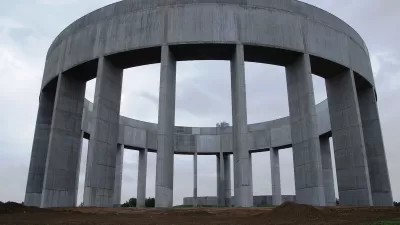Researchers are beginning to understand how the human brain is hard-wired to respond to certain patterns, colors, and proportions. The result is "a revolution in the science of design," says Lance Hosey, and "most people...aren’t even aware of it."
German researchers have shown that "shades of green can boost creativity and motivation;" a Duke University professor has demonstrated the rationale behind the "golden rectangle;" and "optimal fractal density" may explain the appeal of Jackson Pollock's paintings. Hosey, the chief sustainability officer at the architecture firm RTKL, discusses "why we love beautiful things" in this essay for The New York Times.
"It should come as no surprise that good design, often in very subtle ways, can have such dramatic effects. After all, bad design works the other way: poorly designed computers can injure your wrists, awkward chairs can strain your back and over-bright lighting and computer screens can fatigue your eyes."
"We think of great design as art, not science, a mysterious gift from the gods, not something that results just from diligent and informed study. But if every designer understood more about the mathematics of attraction, the mechanics of affection, all design — from houses to cellphones to offices and cars — could both look good and be good for you."
FULL STORY: Why We Love Beautiful Things

Planetizen Federal Action Tracker
A weekly monitor of how Trump’s orders and actions are impacting planners and planning in America.

Chicago’s Ghost Rails
Just beneath the surface of the modern city lie the remnants of its expansive early 20th-century streetcar system.

San Antonio and Austin are Fusing Into one Massive Megaregion
The region spanning the two central Texas cities is growing fast, posing challenges for local infrastructure and water supplies.

Since Zion's Shuttles Went Electric “The Smog is Gone”
Visitors to Zion National Park can enjoy the canyon via the nation’s first fully electric park shuttle system.

Trump Distributing DOT Safety Funds at 1/10 Rate of Biden
Funds for Safe Streets and other transportation safety and equity programs are being held up by administrative reviews and conflicts with the Trump administration’s priorities.

German Cities Subsidize Taxis for Women Amid Wave of Violence
Free or low-cost taxi rides can help women navigate cities more safely, but critics say the programs don't address the root causes of violence against women.
Urban Design for Planners 1: Software Tools
This six-course series explores essential urban design concepts using open source software and equips planners with the tools they need to participate fully in the urban design process.
Planning for Universal Design
Learn the tools for implementing Universal Design in planning regulations.
planning NEXT
Appalachian Highlands Housing Partners
Mpact (founded as Rail~Volution)
City of Camden Redevelopment Agency
City of Astoria
City of Portland
City of Laramie




























